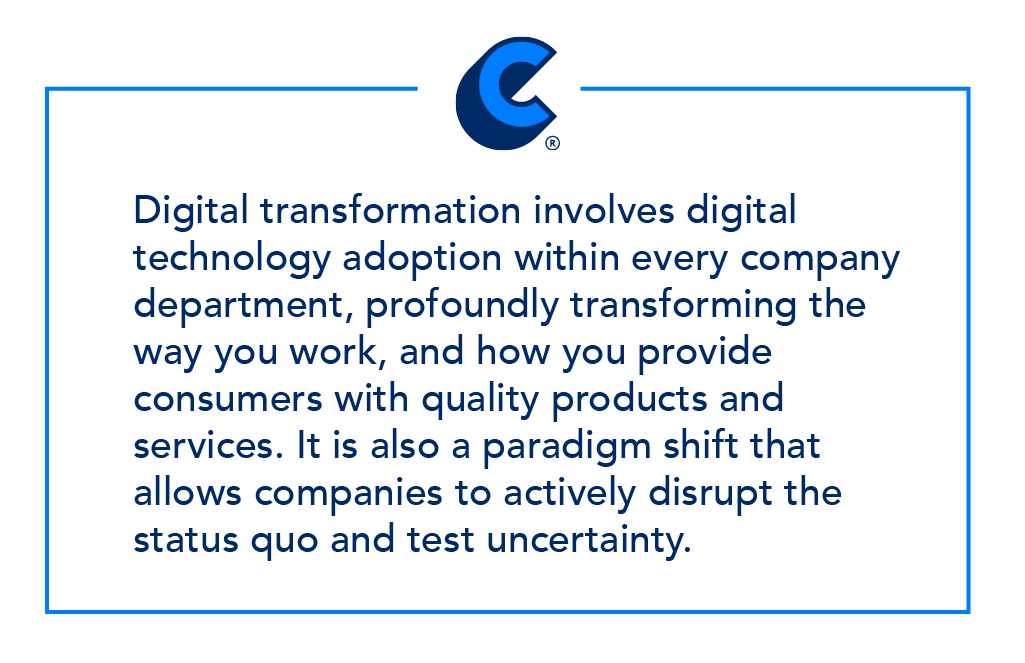As a method, digital transformation includes the usage of digital technologies to generate new or improved business processes, environments, and customer experiences to satisfy evolving company and consumer demands. Digital transformation proposes a new way of working in the digital age.
Further, this surpasses traditional views on processes such as distribution, brand management, and customer experience. Alternatively, digital transformation intersects how you feel about and engage with your consumers.
Digital transformation involves digital technology adoption within every company department, profoundly transforming the way you work, and how you provide consumers with quality products and services. It is also a paradigm shift that allows companies to actively disrupt the status quo and test uncertainty.

Even digitally-morphing companies face the persistent obstacles of budgeting, workforce hurdles, and the shift in present-day attitudes.
Organizations kept paper records for much of our recorded industrial history. Business information was often identical, whether handwritten in books or typed into texts. You handled physical records—papers and binders, xeroxes and faxes—if you wanted to exchange information.
Nonetheless, machines soon became popular, and most organizations started integrating all of these paper records into digital documents. The method of transferring material from paper to digital is called digitization.
Information was much easier to locate and divulge when it was digitized, but the way industries used their modern digital records predominantly tried to replicate the old manual methods. Software operating systems were designed to feel comfortable, and less intrusive, with icons simulating file folders. Yet, even though data was being digitized, the organizational systems and processes were still built around the mainstays of the analog era.

What is the importance of digital transformation?
There are a variety of reasons a business may undergo digital transformation. For example, to survive in the digital age.
Companies are, for instance, at different stages on the road towards digital transformation. Nevertheless, a quick pace has become a necessity for everybody. IT executives face continuous challenges to demonstrate that new projects continue to bring the company’s potential for power and speed to life.
Enhancing the customer experience has always been a major objective, and indeed a key component of digital transformation. Yet, digital transformation can vary greatly depending on a company’s unique challenges and consumer demands. Nonetheless, there are also many constants which all organizations must plan for to achieve overall success.
Plus, digitization has already changed customer service forever by offering the instant gratification of having the immediate ability to easily pull customer records from any company-connected device. In addition, the process of searching for relevant data has also become much more efficient.
When the digital revolution continued its progress, people began to formulate strategies for using technology in novel ways—and not just to make things easier. It was at this point where we started to develop the idea of digital transformation. Technological advances have essentially made these new tools viable and have provided new ways of getting tasks completed.
While IT will play a critical role in leading the digital transformation agenda, it remains up to everyone to continue to incorporate and assimilate to the drastic changes that can characterize digital transformation. Digital transformation is therefore a human problem.
With cross-functional departments, IT executives collaborate more now than ever before. Measures of digital change also restructure workgroups, employment, and long-term workflows. IT executives may sense a blowback because people could fear their worth, and perhaps their careers, are in jeopardy. As a result, soft skills in leadership are mandatory.
According to a Capgemini Digital Transformation Institute and MIT Sloan School of Management report, digital transformations are stagnating or failing for several reasons, which encompasses bad leadership, miscommunication between IT and the company, lackluster staff engagement, and poor processes. So, let’s take a look at the history, then discuss best practices to help ensure a successful digital transformation.


